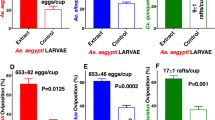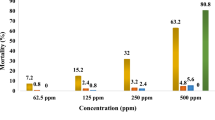Abstract
An extract of the hydrophyteMyriophyllum spicatum L. was found to be toxic to first- and fourth-instar larvae of the mosquitoes,Culex quinquefasciatus Say,Culex tarsalis Coquillett,Culiseta incidens (Thomson),Aedes aegypti L., and chironomid midges in the laboratory. When first-stage larvae were exposed to the extract, the lowest concentration (6.4 mg extract/100 ml H2O) produced 86,60, and 48% mortality inC. incidens, C. quinquefasciatus, andA. aegypti, respectively. Higher concentrations caused 100% mortality in both first and fourth instars (63.75 mg/100 ml H2O or more). In general, the biocidal activity of the extract was found to be similar when first- and fourth-stage larvae were exposed. Some mortality in the successive pupal and adult stages was observed when fourth-stage larvae were exposed to the extract, but mortality occurred only in the various larval instars when first instars were exposed. Among the chironomids,Tanytarsus spp. was more tolerant to the extract thanChironomus spp. In addition to the biocidal activity against immature mosquitoes, the extract was found to show a unique activity acting as an attractant to both sexes of adultC. quinquefasciatus andA. aegypti. The response elicited inA. aegypti appeared to be somewhat higher than that inC. quinquefasciatus. In general, the percentage of males responding to water treated with the extract was higher than that of the females. The extract at higher concentrations seemed to show some repellency at the outset to both species, but induced positive responses later on.
Similar content being viewed by others
References
Angerilli, P.D.C., andBeirne, B.P. 1974. Influence of some freshwater plants on the development and survival of mosquito larvae in British Columbia.Can. J. Zool. 52:813–815.
Bachmann, A. 1921. A programme to be carried out in Familla againstAnopheles and their larvae (In Spanish).An. Dept. Nac. Higiene, Buenos Aires. 27:117–137.
Dhillon, M.S., andMulla, M.S. 1981. Biological activity of the green algaChorella ellipsoidea against immature stages of mosquitoes.Mosq. News. 41:368–372.
Dhillon, M.S., Mulla, M.S., andHwano, Y.-S. 1982. Biocidal activity of algal toxins against immature mosquitoes.J. Chem. Ecol. 8:557–566.
Furlow, B.M., andHays, K.L. 1972. Some influences of aquatic vegetation on the species and number of Culicidae (Diptera) in small pools of water.Mosq. News 32:595–599.
LaLonde, R.T., Wong, C.F., Hofstead, S.J., Morris, C.D., andGarnder, L.C. 1980.N-(2-MethyIpropyl)-(E,E)-2-4-decadienamide: A mosquito larvicide fromAchillea millefolium.J. Chem. Ecol. 6:35–48.
Matheson, R., andHinman, E.H. 1929. Further studies onChara spp. and other aquatic plants in relation to mosquito breeding.Am. J. Trop. Med. 9:249–266.
Mulla, M.S., andChaudhury, M.F.B. 1968. Effects of surface tension on pupae ofCulex pipiens quinquefasciatus Say andAedes aegypti L.Mosq. News 28:187–191.
Mulla, M.S., andKhasawinah, A.M. 1969. Laboratory and field evaluation of larvicides against chironomid midges.J. Econ. Entomol. 62:37–41.
Mulla, M.S., Darwazeh, H.A., andNorland, L.E. 1974. Insect growth regulators: Evaluation procedures and activity against mosquitoes.J. Econ. Entomol. 67:329–332.
Pennak, R.W. 1973. Some evidence foraquatic macrophytes as repellents for limnetic species ofDaphnia.Int. Rev. Gesamten. Hydrobiol. 58:569–576.
Smith, J.B. 1910. Azolla vs. mosquitoes.Entomol. News 21:437–441.
Twinn, C.R. 1931. Observation on some aquatic animal and plant enemies of mosquitoes.Can. Entomol. 63:51–61.
Author information
Authors and Affiliations
Rights and permissions
About this article
Cite this article
Dhillon, S., Mulla, M.S. & Hwang, YS. Allelochemics produced by the hydrophyteMyriophyllum spicatum affecting mosquitoes and midges. J Chem Ecol 8, 517–526 (1982). https://doi.org/10.1007/BF00987799
Received:
Revised:
Issue Date:
DOI: https://doi.org/10.1007/BF00987799




